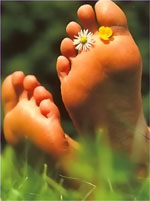 |
REFLEXOLOGY
with Helen Binge |
 |
 |
REFLEXOLOGY
with Helen Binge |
 |
This form of treatment dates back to Ancient Egypt, and is also thought to have been used by the ancient Chinese and Hindus. However it was only at the beginning of the 20th century that Dr. William H. Fitzgerald in Connecticut U.S.A. discovered zone therapy. He divided the human body into longitudinal portions going from the head towards the feet, and from the head towards the hands. After this, his assistant, Eunice D. Ingham researched and developed better understanding of these zones. In 1930 she produced maps of the plantar reflex zones of the body, and this is the basis of reflexology we use today.
How does it work?
On the whole of the foot and hand we may find a map of the total body and it can be said that the foot is a microcosm of the human body with all the organs, glands and structures represented. These reflex zones correspond to specific parts of the body. When an organ is not working efficiently, the corresponding zone will change in its sensitivity to touch. Massage of these zones has an effect on the corresponding part of the body. The foot gives us important information of the state of health of the patient, by the structure, colour, texture as well as the sensitivity of certain precise points. Reflexology has both relaxing and stimulating properties. When the circulatory and lymphatic systems are stimulated, reflexology assists in the elimination of toxins and allows the body to return to a natural harmony. It brings about a balance and a homeostasis in the body as well as reducing nervous and muscular tension.
Reflexology does not directly treat a symptom, it works on the cause of the underlying problem.
It is of course imperative for the reflexologist to understand completely the anatomy, physiology and underlying pathology. This helps in the discovery of the root cause of the trouble and the reason for the poor functioning of an organ or zone.
A course of reflexology may need several seances for the body to heal naturally. Normally the first session will consist of a full assessment of the feet in order to understand the patient's individual needs. Subsequent treatment would then consist of massage to certain zones on the feet, or perhaps the hands if this is seen to be appropriate. In some cases the relief is rapid, other cases may require further perseverance.
Why choose Reflexology?
- This therapy is completely natural.
- Reflexology may be practiced on people of all ages, from small infants to the very elderly.
- It is extremely efficient as a prevention of illness and a means of maintaining good health as well as the treatment to restore good health.
- It is helpful for both acute and chronic pain and a variety of illnesses.
- It is particularly helpful to reduce tension and stress.
This therapy is completely natural, bringing comfort, well-being and restoring harmony. Today, this technique is gaining popularity all the time in many countries all over the world. It is sometimes performed by and often done in collaboration with Doctors, Physiotherapists, Osteopaths, Midwives and other members of the medical profession.
Helen Binge is a fully qualified Chartered Physiotherapist from Great Britain as well as a certified Reflexologist.
For further information, please contact Helen Binge M.C.S.P. Grad. Dip. Phys on Tel: 022 776 7761